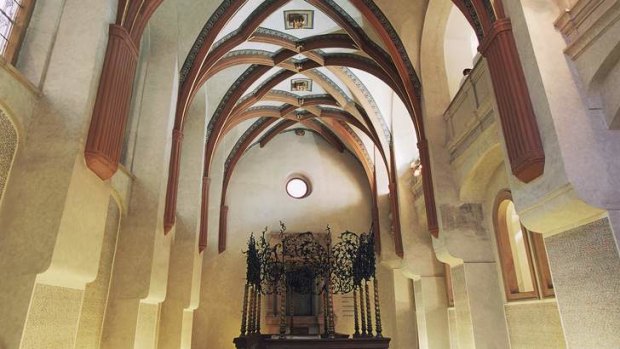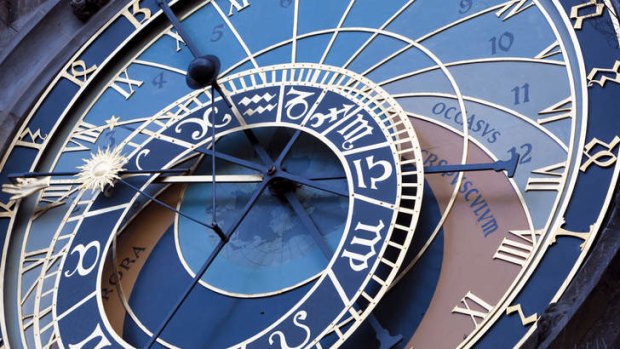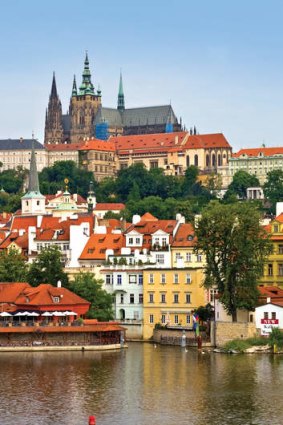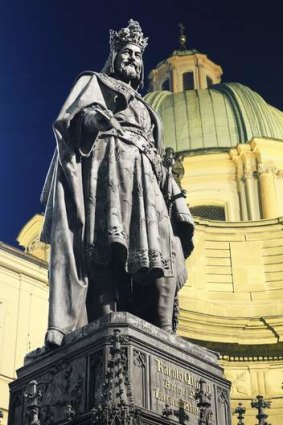
Pinkas Synagogue in the Jewish Quarter.Credit: Getty Images
Prague offers a rare window into some of Europe's most dramatic moments, writes Sue Bennett.
In a dingy, non-descript passageway close to Prague's National Theatre is a bronze plaque comprising sculpted, open hands with the date "17.11.1989" in relief below. It's easy to miss but its significance is lost on no one with the scantest knowledge of this beautiful city's recent history.
It marks the moment when communism began its rapid collapse, when students and, later, hundreds of thousands of ordinary Czechs took to the streets, theatres and squares to protest, not with weapons, but with outstretched hands. Not a shot was fired, hence the name "Velvet Revolution", and it ended 41 years of communist rule as part of the Soviet bloc.

The astronomical clock at Prague Town Hall.Credit: Getty Images
Prague is full of small and large monuments, grand and spectacular sights. They tell the story of a landlocked country at the epicentre of central Europe which, for much of its existence, was pulled, pushed and governed by its neighbouring great powers.
A few years ago, when Czech television asked its viewers to nominate their greatest countryman or woman, more than 250,000 responded. Not for them any modern-day hero but 14th-century King Charles IV. He not only ruled Bohemia, loosely today's Czech Republic, but was King of Italy, the Romans and the Holy Roman Empire.
It was a high point about which today's Czechs remain fiercely proud. Sensitivities about recent history are constantly displayed.

Yesterday today: cityscape below Prague Castle.
"It was always a Czech government and administration in control - with Soviet advice," says tour guide Helena Trnkova, later describing how Russian was compulsory in her school years and conceding: "We never really knew what was going on, there was no freedom, the borders were closed and people were afraid to speak. It was difficult."
It makes fascinating vignettes for today's visitor. My hotel, now Radisson Blu Alcron, was the swankiest in town in "socialist times" and, when it was renovated years later, the ashtrays in all the bedrooms were found to have been been bugged. A far more chilling reminder of those times is seen at the Museum of Communism, which includes a reconstructed interrogation room.
Quite incongruously, the museum's entrance, off the busy, pedestrianised shopping street of Na Prikope, is beside a McDonald's and shares a grand, if faded entrance with a casino. Fashion house Zara is opposite. The old guard would weep.

Charles IV, 14th-century ruler.
The largest statue of Stalin ever built once towered over the city, but in 1962 Soviet leader Nikita Khrushchev had it blown up - the only way to budge it.
However, explosions have been rare in Prague. Despite its turbulent political history, the city's buildings survive largely intact. Its 866-hectare centre is UNESCO World Heritage listed.
Even a large part of its Jewish legacy is there to see, unlike many other European cities, where all the evidence was destroyed by the Nazis. Chillingly, it is said Adolf Hitler saved Prague's quarter so it could become "a museum to an extinct race".
That museum - in different parts but close proximity - is among the most visited sites by the Czech Republic's 7 million annual visitors. In the Pinkas Synagogue, the names of 80,000 Bohemian and Moravian Jewish Holocaust victims are inscribed on the walls. Upstairs, children's drawings from Terezin Concentration Camp (about one hour outside Prague and open to the public) are displayed. Most youngsters died at Auschwitz.
Outside, a cemetery dating from 1439 and used until 1787, has almost 12,000 headstones over a tiny area, but more than 100,000 Jews are buried here, up to 10 deep. The museum is in the Old Town, dating from 1230. There's also the Castle District, Lesser or Little Quarter and New Town, which dates from 1348.
Walk through the narrow, cobbled laneways, into tiny squares and beneath stone arches for a taste of the city's antiquity. Then enter Old Town Square, dominated by the Gothic beauty of the Church of Our Lady Before Tyn and surrounded by tall, narrow ornate buildings in candy shades of pink, cream and pale green.
Beside the town hall, the famous astronomical clock shows the position of the sun and moon and, each hour, there's the "Walk of the Apostles", when figures, including a skeleton representing death, parade across the clock. It was made in 1410 and attracts huge crowds, so try to go early.
Likewise, head for Charles Bridge, initiated by our hero, King Charles IV, outside the busiest times. It's 520 metres long, built of stone and was opened at the start of the 15th century. Today, the statues lining the cobbled walkway look down on a sea of tourists, buskers and artists touting for commissions.
Go early. That way, you get the full impact of the approach from the Old Town, crossing the wide Vltava River on Charles Bridge, and heading up to Prague Castle, a massive structure that dominates the city skyline. The size of seven football fields, it dates from the ninth century and is home to palaces, a convent, gardens and St Vitus Cathedral, built by Charles IV. Like all Prague, it's a glorious mix of fine gothic and baroque architecture. Back down in town, add art nouveau to the mix.
Wander back through the quiet streets, looking above doorways in Nerudova Street for illustrative plaques used to show a house's name before the advent of street numbers.
Make your way to Legion Bridge, which has magnificent castle and river views, but just before crossing, stop at Cafe Savoy, a beautiful coffee house with a high, gilded ceiling, crystal chandeliers, in-house bakery and divine cakes. I opt for a Prague favourite - thick, warm ham with creamy grain mustard, fresh horseradish and slightly vinegary, slightly sweet gherkins. It's with brown bread (a hint of caraway seeds) and it's the best dish I eat in Prague.
At Kolkovna, a chain of restaurants serving Czech dishes, I choose roast leg of young goose with large, not-very-fluffy, potato dumplings and apple-flavoured sauerkraut. I could have opted for the all-time national favourite of roast beef in cream sauce, goulash or duck with "Moravian sparrows" (pieces of roast pork). Menus get a bit lost in translation everywhere - I didn't try, intriguing as it was, "chicken in the style of pheasant".
It's all good fodder for beer, which Czechs are very good at making and drinking. Pilsner Urquell is ubiquitous, but there is also a host of boutique brands. Czechs remain the world's biggest beer drinkers per capita, downing about 150 litres each a year, and that's despite zero tolerance laws for drivers.
Brewing is important to the country's economy but it's nothing compared with engineering. Today, it's an important centre of car production. Between World War I and World War II, the then-Czechoslovakia was among the world's 10 wealthiest nations, thanks largely to its engineering skills. On the drive from the airport, the road is lined by imposing, expensive houses from this period.
The economy stagnated through the socialist years but Prague's remarkable good fortune in remaining largely intact through centuries of turbulent history makes it a huge drawcard for today's visitors - tourists carrying nothing more threatening than a credit card.
The writer travelled as a guest of APT.
TRIP NOTES
VISITING THERE
Travellers on many APT Royal Collection river cruises can extend their holidays at either end of a cruise with an escorted city visit to places like Prague. Each group is led by an APT tour director with English speaking guides. Spend three nights in Prague before or after an APT river cruise on an 18-day Magnificent Europe all-inclusive cruise from Amsterdam to Prague, priced from $9645 a person twin share for 2015 departures. See aptouring.com.au.
GETTING THERE
Free return flights between Australia and Europe with Singapore Airlines are available for bookings made with APT by October 31.
STAYING THERE
APT holidays feature stays in luxury hotels. In Prague, guests stay at the Radisson Blu Alcron Hotel. Art deco in style, it's home to one of the city's two Michelin-starred restaurants, with famous Wenceslas Square just around the corner.
MORE INFORMATION
Sign up for the Traveller Deals newsletter
Get exclusive travel deals delivered straight to your inbox. Sign up now.